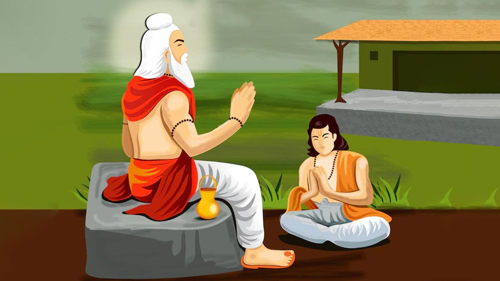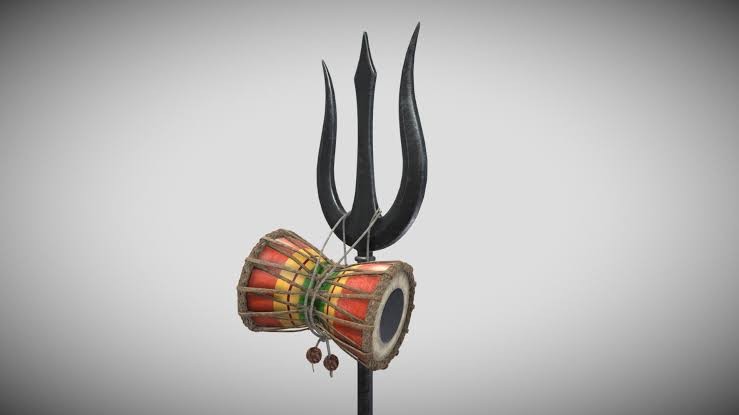
Dharma vs Religion: Why Sanatana Wisdom Goes Beyond Blind Faith
Blog
Discover the profound difference between Dharma and Religion through the lens of Sanatana Dharma. 🌼 Explore how Dharma is rooted in knowledge, inner realization, and universal laws—unlike religion, which relies on belief and obedience. Learn why a Guru is not a prophet, and how spiritual freedom and inquiry lie at the heart of the world's oldest tradition. 🔍🪔
594
Shivam Gangwar
9 min
Apr 24, 2025
🌼 Dharma vs Religion: Why They’re Not the Same 🕉️
Understanding Dharma, Religion, Guru, and Prophet from a Sanātana perspective
🔹 Introduction
In the modern world, we often hear people use “Dharma” and “Religion” as if they mean the same thing — but they are fundamentally different. 📚 Likewise, many people use the word “Guru” as a substitute for “Prophet” or “Nabi,” but that too is a simplification.
Let’s dive deep into the world of Sanātana Dharma 🕉️ and discover how these terms reflect entirely different worldviews. 🌍
✨ 1. Dharma ≠ Religion (Mazhab)
The word Religion (or Mazhab) comes from Abrahamic traditions like Christianity, Islam, and Judaism. These systems follow the concept of:
- One God 🙏
- One Book 📖
- One Prophet 🌟
Belief is the cornerstone here. Either you accept the prophet and the book — or you’re excluded from salvation, regardless of your actions.
But in Sanātana Dharma, the approach is entirely different.
✅ Dharma is not belief-based — it is knowledge-based.
✅ You are free to question, explore, accept, or reject ideas.
✅ Even an atheist can live a dhārmic life if they live with integrity and kindness.
Dharma is not a brand or a group you join. It is cosmic law — the principle that governs balance in the universe. 🌌
🧠 2. Sanātana Dharma Embraces Logic and Freedom
Sanātana Dharma encourages debate, discussion, and logical thinking. 🧠 One of its core schools of thought is Nyāya Śāstra, which is completely focused on logic and reasoning. 🔍
In ancient India, debates between Hindus, Buddhists, and Jains were common. People were never punished for disagreeing — they were invited to debate openly.
One legendary figure, Acharya Sri Harsha, even challenged the very principles of logic (Nyāya) in his brilliant work Khaṇḍana-Khaṇḍa-Khādya. His criticisms were so profound that a new school, Navya Nyāya (New Logic), was born.
How cool is that? A tradition that questions its own logic — and evolves from it! 🔁💥
🧘 3. Guru ≠ Prophet or Nabi
The Prophet in Abrahamic traditions is someone chosen by God to deliver divine revelations. They are seen as unique for that time and place.
But in Sanātana Dharma, the Guru is different. A Guru is not just a teacher — the word literally means:
👉 Gu = Darkness
👉 Ru = Remover
The Guru removes ignorance and guides you toward self-realization. 🌞
There are many types of Gurus (as mentioned in Guru Gītā), but the highest is the Paramguru — someone who has become one with the Divine. Such Gurus exist not because a God “sent” them, but because they have realized the truth through their own sādhanā (spiritual practice).
✅ Multiple Gurus can exist at the same time.
✅ Each Guru guides seekers in their own unique way.
✅ Gurus speak from experience, not from a divine command.
This is a big difference from the concept of a Prophet. ✨
🌱 4. Dharma is Universal, Not Limited by Belief
Dharma doesn’t ask you to convert, obey, or even believe in a specific deity. It is based on universal truths that apply to all human beings:
🌿 Law of Karma – What you do, you receive.
🌀 Rebirth – Life is a cycle until liberation (Moksha).
🧬 Five Koshas – We are more than just the body.
🌈 Chakras & Nādīs – Subtle energy systems within us.
🌿 Ayurveda – Balance of Vāta, Pitta, and Kapha.
Even if someone doesn’t believe in any of these ideas, their effects still apply. That’s why Sanātana Dharma is more of a spiritual science than a religion. 🔬
🤝 5. Inclusivity of Sanātana Dharma
What makes Dharma truly special is its open-heartedness. ❤️
🔹 A theist, atheist, agnostic — all have a place.
🔹 You are not condemned for doubt — you are welcomed to explore.
🔹 Dialogue is more important than dogma.
Every scripture — from the Bhagavad Gītā to the Upanishads — is full of dialogues, not commandments. 🗣️✨
In fact, Arjuna questioned Krishna himself before accepting his wisdom. That’s the spirit of Dharma — freedom of thought blended with respect for truth.
🌟 Conclusion: Know the Difference, Respect the Essence
Dharma is not a label. It’s a way of life.
It’s about living in harmony with yourself, nature, and the universe. 🌺
Guru is not a messenger, but a light who guides you from ignorance to wisdom through personal experience. 🔥
Let’s honor these profound differences — not just to correct language, but to reclaim the depth and beauty of Sanātana Dharma. 🌼🕉️
🪔 “Ekam sat vipra bahudha vadanti” — Truth is one, sages express it in many ways.
🌸 Om Tat Sat 🙏
🌼 धर्म बनाम मज़हब: क्यों दोनों एक जैसे नहीं हैं? 🕉️
सनातन दृष्टिकोण से धर्म, मज़हब, गुरु और पैगंबर को समझना
🔹 भूमिका
आजकल “धर्म” और “Religion” (या मज़हब) को अक्सर एक ही अर्थ में इस्तेमाल किया जाता है, लेकिन असल में ये दोनों पूरी तरह से अलग हैं। 📚
इसी तरह “गुरु” शब्द को भी कई बार “Prophet” (पैगंबर/नबी) के रूप में बताया जाता है — जबकि इनमें ज़मीन-आसमान का फर्क है।
आइए, हम सनातन धर्म 🕉️ की गहराई में उतरें और समझें कि ये शब्द वास्तव में क्या दर्शाते हैं। 🌍
✨ 1. धर्म ≠ मज़हब (Religion)
Religion या मज़हब शब्द अब्राह्मिक परंपराओं (ईसाई, इस्लाम, यहूदी) से आए हैं। इन विश्वासों की मूल सोच यह है:
- एक ईश्वर 🙏
- एक किताब 📖
- एक पैगंबर 🌟
यहाँ मुख्य बात है – श्रद्धा।
यदि आप उस पैगंबर, किताब और ईश्वर को मानते हैं — तो मुक्ति है। अगर नहीं मानते, तो कोई भी अच्छे कर्म आपको नहीं बचा सकते।
🌼 लेकिन सनातन धर्म की सोच बिलकुल अलग है।
✅ धर्म विश्वास पर नहीं, बल्कि ज्ञान पर आधारित है।
✅ आप किसी भी विचार को चुनौती दे सकते हैं, पूछ सकते हैं, इनकार भी कर सकते हैं।
✅ एक नास्तिक भी धर्म के मार्ग पर चल सकता है अगर वह अच्छे कर्म करे।
धर्म कोई संगठन नहीं, न ही कोई ब्रांड — यह ब्रह्मांड का स्वाभाविक नियम है। 🌌
🧠 2. सनातन धर्म में तर्क और स्वतंत्रता का स्थान
सनातन धर्म में तर्क और मंथन को बढ़ावा दिया गया है। 🧠
यहाँ एक सम्पूर्ण दर्शनों का स्कूल है — न्याय शास्त्र — जो सिर्फ तार्किक विचारों पर आधारित है। 🔍
प्राचीन भारत में हिंदू, बौद्ध और जैन धर्म के विद्वानों के बीच खुली बहसें होती थीं। कोई भी दंडित नहीं होता था — विचारों का आदान-प्रदान होता था।
एक प्रसिद्ध विद्वान आचार्य श्री हर्ष ने न्याय दर्शन की ही मूलभूत मान्यताओं को अपनी रचना खण्डन-खण्ड-खाद्य में चुनौती दी। यह कृति इतनी प्रभावशाली थी कि इससे नव्या न्याय नामक नया स्कूल खड़ा हो गया।
सोचिए, एक ऐसा धर्म जिसमें अपने ही सिद्धांतों को चुनौती देकर उन्हें और सशक्त बनाया जाता है! 🔁💥
🧘 3. गुरु ≠ पैगंबर या नबी
अब्राह्मिक परंपराओं में पैगंबर वह होता है जिसे ईश्वर (या जिब्रईल जैसे देवदूत) द्वारा चुना गया हो और ईश्वरीय सन्देश दिया गया हो।
लेकिन सनातन धर्म में गुरु का अर्थ कुछ और ही है।
👉 गु = अंधकार
👉 रु = दूर करने वाला
👉 गुरु = अज्ञानता को मिटाने वाला
गुरु वह होता है जिसने स्वयं सत्य को जाना है, और आत्मज्ञान प्राप्त किया है। 🌞
गुरु कोई संदेशवाहक नहीं, बल्कि ज्ञान का साक्षात स्रोत होता है।
✅ एक समय में कई गुरु हो सकते हैं
✅ हर गुरु अपने अनुभव से मार्ग दिखाता है
✅ गुरु स्वयं दिव्यता में स्थित होता है — यह किसी बाहरी चयन की बात नहीं
यह सोच पैगंबर की परिभाषा से बहुत भिन्न है। ✨
🌱 4. धर्म सार्वभौमिक है, सिर्फ आस्था पर नहीं टिका
धर्म किसी विशेष समुदाय या मान्यता तक सीमित नहीं है। यह सभी मनुष्यों पर लागू होने वाले सार्वभौमिक सिद्धांतों पर आधारित है:
🌿 कर्म का नियम – जैसा करोगे, वैसा पाओगे
🌀 पुनर्जन्म – जीवन एक चक्र है, मोक्ष तक
🧬 पाँच कोश – हम सिर्फ शरीर नहीं, पाँच परतों से बने हैं
🌈 चक्र और नाड़ी तंत्र – सूक्ष्म ऊर्जा हमारे अंदर बहती है
🌿 आयुर्वेद – वात, पित्त, कफ की संतुलित संरचना
चाहे आप इन पर विश्वास करें या न करें, ये सिद्धांत सभी पर समान रूप से लागू होते हैं। यही कारण है कि सनातन धर्म एक आध्यात्मिक विज्ञान है, न कि केवल एक धर्म। 🔬
🤝 5. सनातन धर्म की समावेशिता
सनातन धर्म की सबसे सुंदर बात यह है कि यह सभी को अपनाता है ❤️
🔹 ईश्वर को मानने वाला, न मानने वाला, संशयवादी — सबका स्वागत है
🔹 संदेह करने वालों को दंड नहीं, विचार का अवसर मिलता है
🔹 संवाद, आज्ञा से ज़्यादा मूल्यवान है
भगवद गीता से लेकर उपनिषदों तक — हर शास्त्र में संवाद शैली अपनाई गई है, आज्ञाएँ नहीं दी गई हैं। 🗣️✨
👉 स्वयं अर्जुन ने श्रीकृष्ण से प्रश्न किए, असहमति जताई — तब जाकर उन्होंने ज्ञान प्राप्त किया।
यही है धर्म की आत्मा — स्वतंत्रता के साथ सत्य की खोज।
🌟 निष्कर्ष: शब्दों का नहीं, सार का सम्मान करें
धर्म कोई टैग नहीं, बल्कि जीवन का मार्ग है।
यह स्वयं, प्रकृति और ब्रह्मांड के साथ सामंजस्य में जीने की कला है। 🌺
गुरु कोई दूत नहीं, बल्कि वह ज्योति है जो अज्ञानता से ज्ञान की ओर ले जाती है 🔥
इन दोनों के बीच के इस गहरे अंतर को समझना और सम्मान देना ही सनातन परंपरा का सम्मान है। 🌼🕉️
🪔 “एकं सद् विप्रा बहुधा वदन्ति” — सत्य एक है, ज्ञानी उसे कई नामों से पुकारते हैं
🌸 ॐ तत् सत् 🙏





